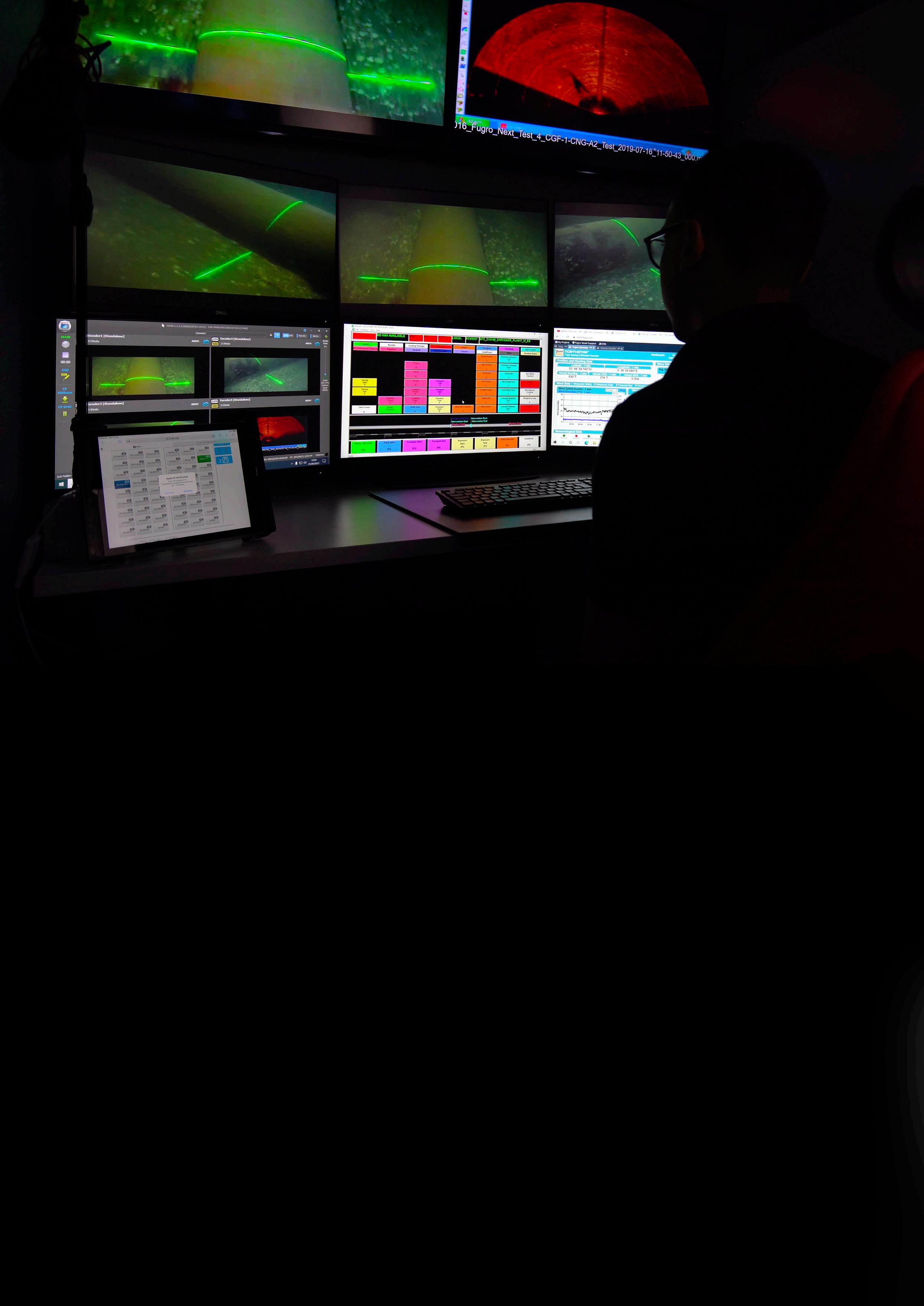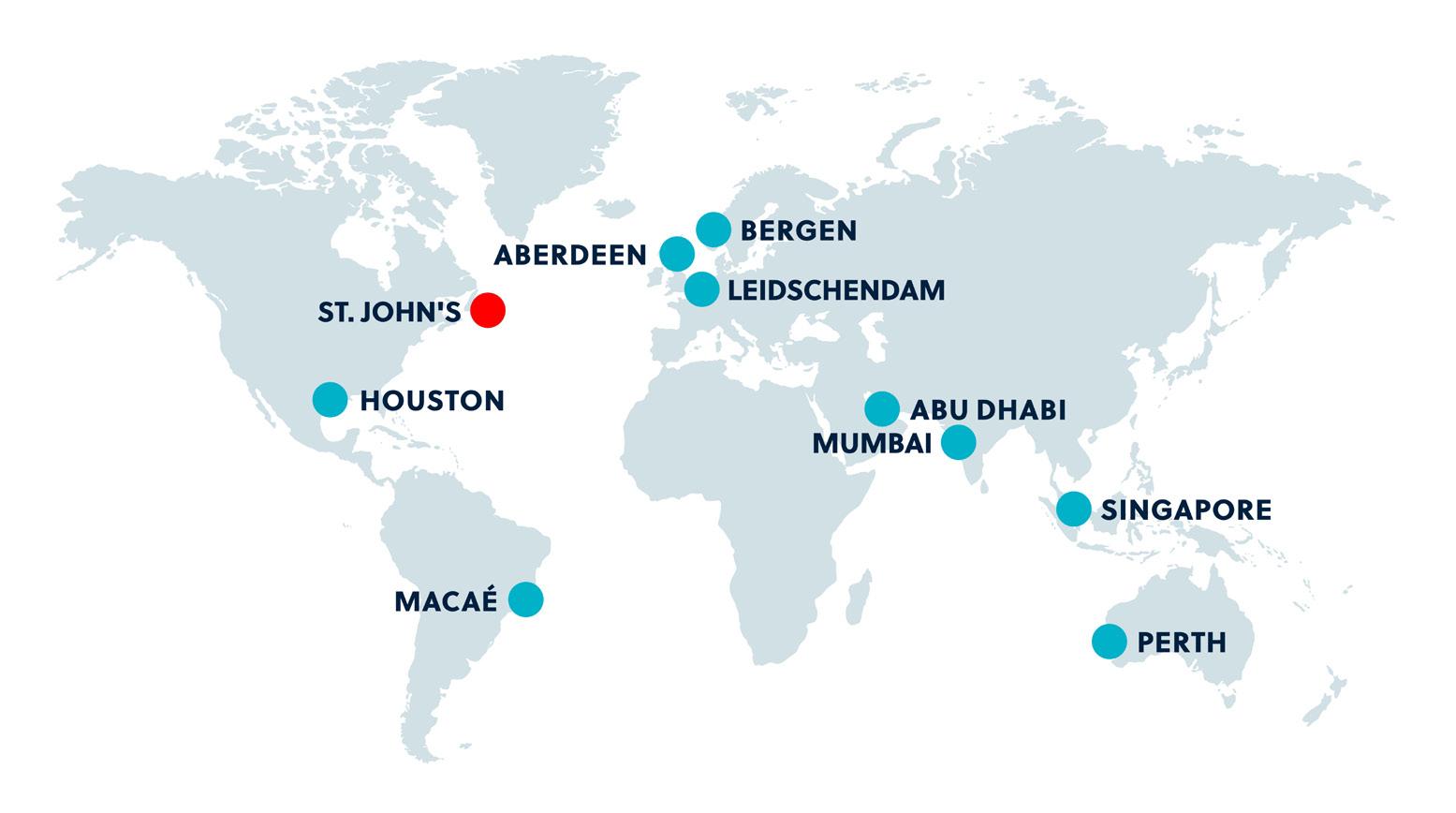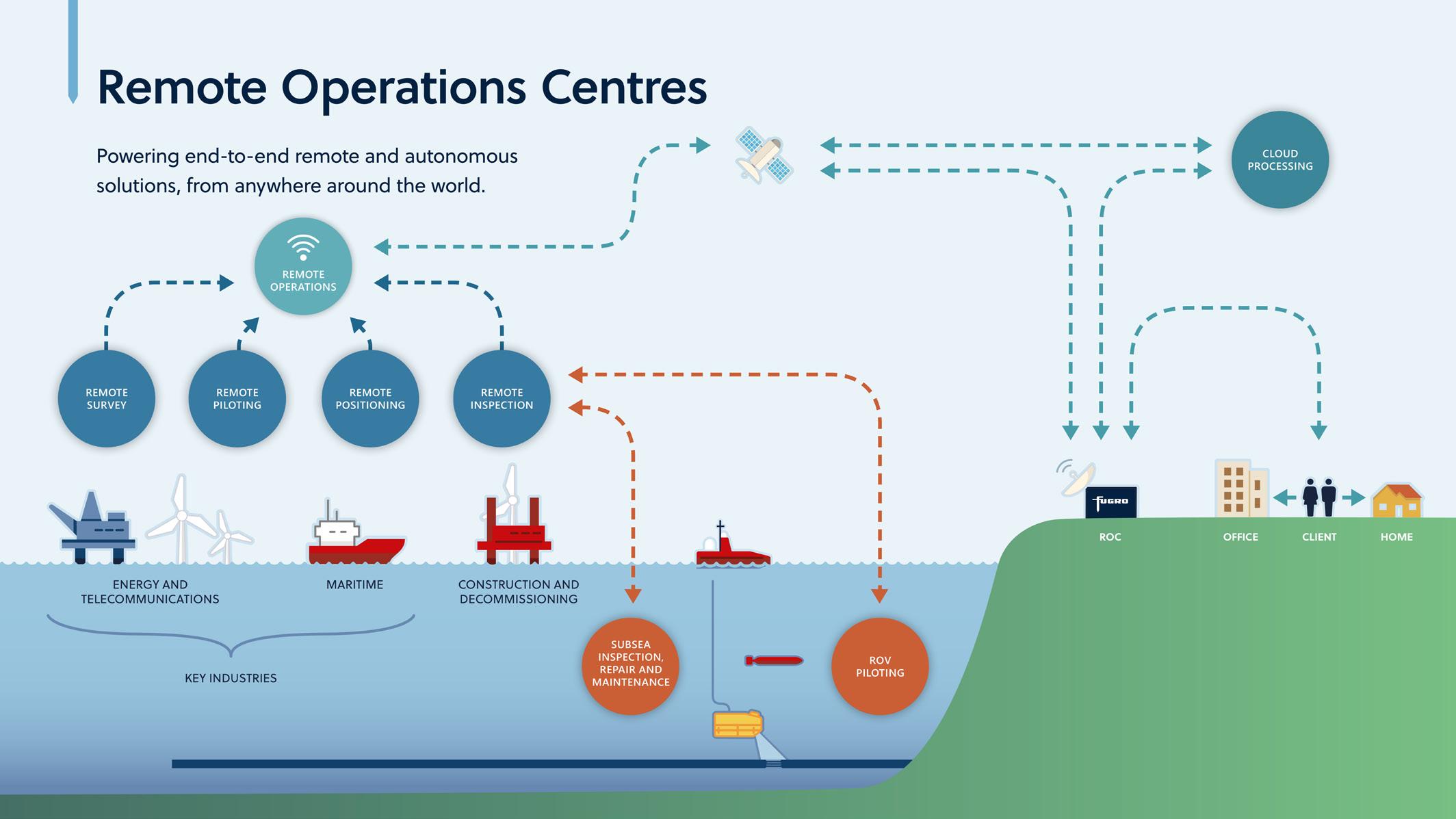
8 minute read
Remote solutions for marine geodata
Figure 1. Surveyor within a Fugro remote operations centre (ROC) performing a pipeline inspection survey. (Image courtesy of Fugro)
The offshore oil and gas industry is experiencing a remote and autonomous revolution, says Rodney Spurvey, Senior Project Manager, Fugro, Canada.
lobal geodata specialist Fugro is a mainstay of Canada’s offshore energy sector. For more than 25 years, the company has worked offshore Newfoundland and Nova Scotia, performing integrated site characterisation and asset integrity services on behalf of the region’s major operators. This work includes a full range of survey activities, including pipeline pre-lay, as-built and inspection surveys, surface and subsea positioning, as well as seismic, geophysical and geotechnical surveys. Historically, these services have been accomplished by mobilising personnel offshore to the project site. That approach is fast changing, however, as Fugro invests in remote and autonomous technologies that allow offshore survey projects to be managed onshore for improved project schedules, operational safety and sustainability. A challenging environment In the province of Newfoundland and Labrador, the region’s four producing oilfields – Hibernia, Terra Nova, White Rose and Hebron – are located in a region of the Grand Banks known as the Jeanne d’Arc Basin. This area is widely recognised as one of the industry’s harshest operating environments. Positioned approximately 350 km offshore from the nearest port in the capital city of St. John’s, icebergs, pack ice, heavy seas and fog blanket the area for much of the year.
Even when conditions are good, the sheer distance from port to field makes transporting personnel and equipment difficult. Helicopters offer the fastest travel option at an approximately 3.5 hr round-trip, but capacity and weight limitations, along with weather factors and a ban on night flying, can wreak havoc on project schedules.
Travel by offshore supply vessels is also problematic. Subject to many of the same weather limitations as helicopters, vessel-based travel takes 36 - 48 hr, which is both time-consuming for staff and expensive for clients. It also prohibits vessels from performing production-focused activities, all while burning as much as 25 000 litres of fuel per dedicated trip. Given the industry’s recent move into the more distant Flemish Pass, these travel obstacles are only likely to grow in the years to come.
A better way There is a better way; advances in communications technology, coupled with an increased commitment to safety and sustainability, prompted Fugro to build a global network of remote operations centres (ROCs). As a result, the company can remove up to 100% of survey personnel from a vessel, enabling work activities to be conducted onshore, away from work hazards and in the comfort of the office.
Fugro currently operates nine ROCs worldwide, ensuring full-system redundancy across the globe. This number will soon increase to ten, as a Canada ROC is currently under construction within Fugro’s St. John’s office. Like the company’s other regional ROCs, the St. John’s facility is strategically positioned to serve major clients and projects. Benefits of the Canada ROC to local clients include: better risk mitigation by removing crew from potentially dangerous offshore work conditions, faster data delivery through access to a global pool of survey experts and in-house remote data processing capabilities, and significantly improved sustainability by reducing the number of personnel deployed offshore and incorporating low-fuel, uncrewed surface vehicles (USVs). The impact of this latter point is significant. Since 2014, Fugro has amassed over 420 000 remote project hours globally. In the US alone, the company estimates it prevented more than 240 t of CO2 from entering the atmosphere.
Building the Canada ROC The new Canada ROC is being constructed with the assistance of the Newfoundland and Labrador Offshore Oil and Gas Industry Recovery Assistance Fund, a programme of the provincial and federal governments. It will focus initially on supporting Newfoundland and Labrador’s offshore oil and gas sector, with plans to make it available for use in other industries both locally and globally.
At 1550 ft2, the Canada ROC will house an operations room configured for up to six ROC surveyors, and a processing room of comparable size and capacity. A bespoke video wall comprising eight 55 in. 4K screens in the operations rooms will aid in situational awareness for the ROC personnel, displaying streaming video, navigation, positioning and other data from the Fugro Starfix® software suite. Network and power systems monitoring weather and vessel traffic information will also be displayed. Content shown on the video wall will also be available within the ROC’s private office spaces, which are designed for client use, as well as within the processing room, upgraded meeting room and new break room. All these work spaces will be fitted with Category 6 Ethernet and fibreoptic cabling, protected by an uninterruptible power supply (UPS).

Figure 2. An example of the challenging work conditions encountered in offshore Newfoundland and Labrador. (Image courtesy of Rodney Spurvey)
Figure 3. Fugro operates a global network of remote operation centres (ROCs). The newest in St. John’s will become operational in late 2022. (Graphic courtesy of Fugro)

The ROC network infrastructure is designed to be ’highly available’ with multiple levels of redundancy and security, isolated from Fugro’s general office network. A redundant internet link from a second service provider has been sourced, with 5G and satellite internet available to add later if needed. Electrical security is ensured by a combination of a wholeROC UPS system and backup power generator, with automatic transfer switch and various remote monitoring abilities.
Canada ROC services Scheduled to open in late 2022, the Canada ROC will be staffed 24 hours a day, 365 days a year, and will be used at the outset to support existing client activities using a variety of innovative technologies. These include:
Remote survey Vessel-based surveys will be conducted using Fugro OARS® command and control technology, which allows onshore surveyors direct access to activities in the field, significantly reducing the required number of persons on board. Fugro OARS is a secure cloud-based technology, optimised for lowbandwidth communications.
Remote inspections and piloting Multiple cameras, radars and intelligent programming will provide inspection engineers with critical situational awareness as they command and control remotely operated vehicles (ROVs) from the ROC during remote inspection and piloting projects. Advanced video streaming technology will allow information from ROVs or any other offshore platform to be efficiently streamed back to the ROC for analysis and storage, while also being made available to clients in real-time via a secure web interface.
Remote positioning Remote positioning of rigs, vessels, barges and subsea assets from the ROC will be carried out using Fugro Starfix and Fugro OARS. This remote solution will supply real-time monitoring of an asset’s position in relation to the variety of hazards offshore, including other vessels, pipelines, structures, etc.
Remote data processing Remote data processing will be performed using two key technologies. For remote surveys, Fugro Back2BaseTM will enable efficient transmission of large datasets over low-bandwidth connections for a rapid start to onshore processing work. For remote pipeline and other inspections, processing will be accomplished using the company’s cloud-based Sense.Suite solution, which also supports immersive 3D visualisations and detailed reporting.


Figure 4. Fugro’s remote operations centres (ROCs) support a wide variety of survey activities for marine industries. Pipeline inspection is a major beneficiary of these capabilities. (Graphic courtesy of Fugro)
Remote expert Using augmented reality (AR) headsets optimised for lowbandwidth satellite communications, Fugro’s Remote Expert capability will allow offshore personnel to share what they see in the field with ROC-based experts for real-time project support.
Fugro will also be able to perform USV-based survey activities from the Canada ROC. Incorporating the latest technologies, including advanced electronics and artificial intelligence, it has designed it’s USV fleet to provide clients with a scalable and flexible project scope based on timecritical decisions. These capabilities will allow Fugro to achieve a 90% reduction in fuel usage while conducting high-speed hydrography, geophysical, ROV and remote inspection surveys.
Canada ROC projects When it comes to Canada-based projects, Fugro’s onshore surveyors are ‘ROC ready’. They have been training for their new roles and are eager to start performing offshore duties onshore as soon as the facility is officially online. Likewise, the company’s processing and client deliverables team is eager to start work in the upgraded facility. With earlier access to project data, they will further streamline the deliverables process, helping clients make better informed decisions, faster.
From an industry perspective, the addition of a remote services option in the region has been well received. Several long-term clients have already expressed interest in using the ROC to remove survey personnel from their inspection, repair and monitoring (IRM) vessels. Typical tasks that will be completed remotely are surface and subsea navigation of the vessel and ROV over subsea assets, streaming video back to shore, and remote subsea survey tasks, such as pipeline inspections. Fugro believes additional operators in the region will also leverage the ROC for their IRM vessel and rig moves, as doing so aligns with industry goals of conducting more operations remotely where possible.
The future Future ROC usage could include projects such as, USV-based hydrographic, environmental, and benthic surveys, along with other tasks such as ice and weather monitoring with appropriate radar or other installed sensors. Year-round monitoring of assets for offshore or onshore meteorological sensor installations is another potential application, as is monitoring of sensor data in support of offshore wind farm installations. The centre can also be made available to industries outside of the offshore energy sector that require constant monitoring of real-time data delivered over the internet.
It is Fugro’s belief that the future is remote and autonomous. ROCs are a key enabler of that strategy and the technology available today allows Fugro to perform survey tasks in ways that could scarcely be imagined only a decade ago. Fugro’s Canada operations are poised to use this technology to benefit their employees, clients and the environment, with increases in safety, productivity, and access to data, coupled with a measurable reduction of environmental impact.

